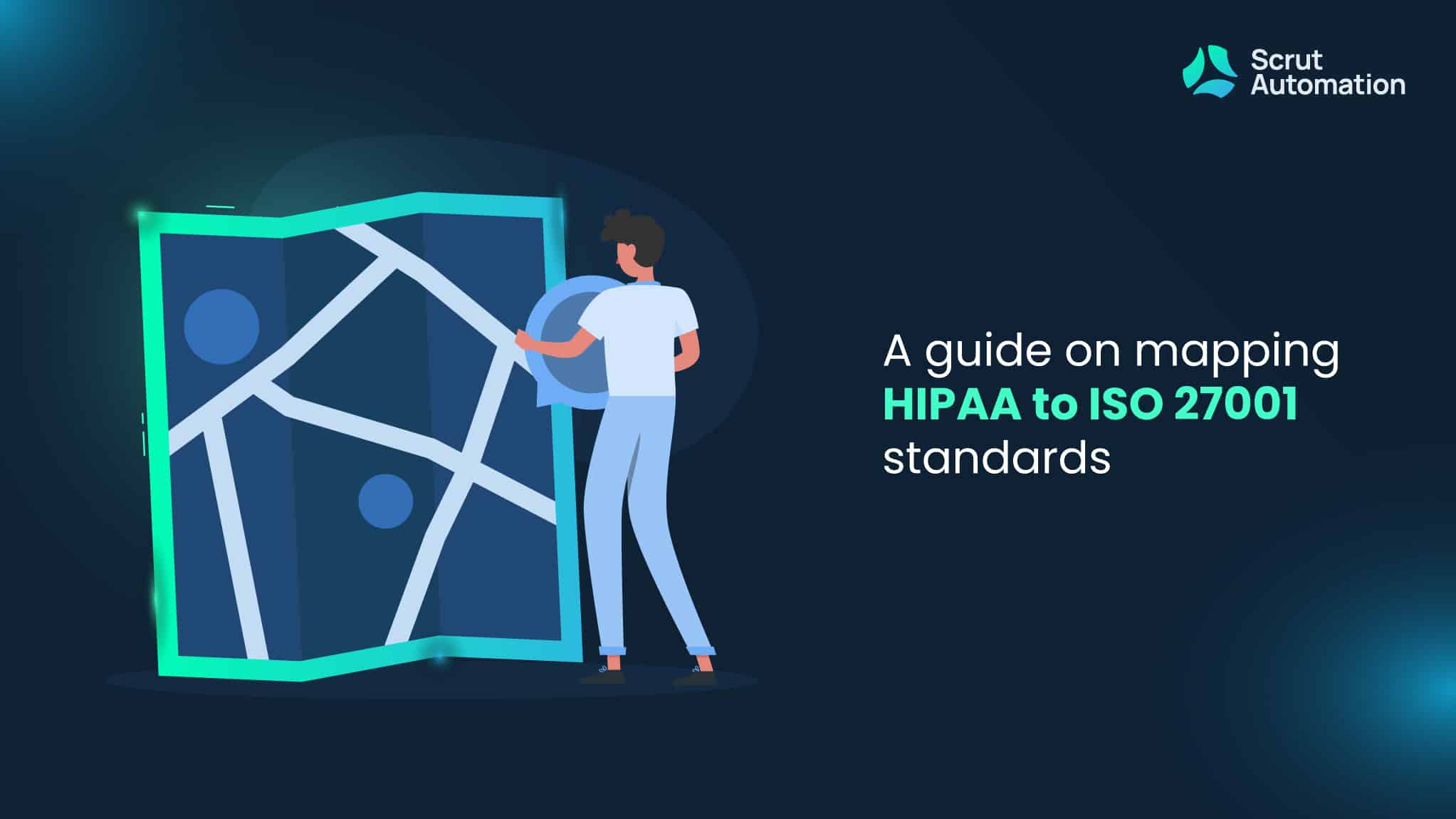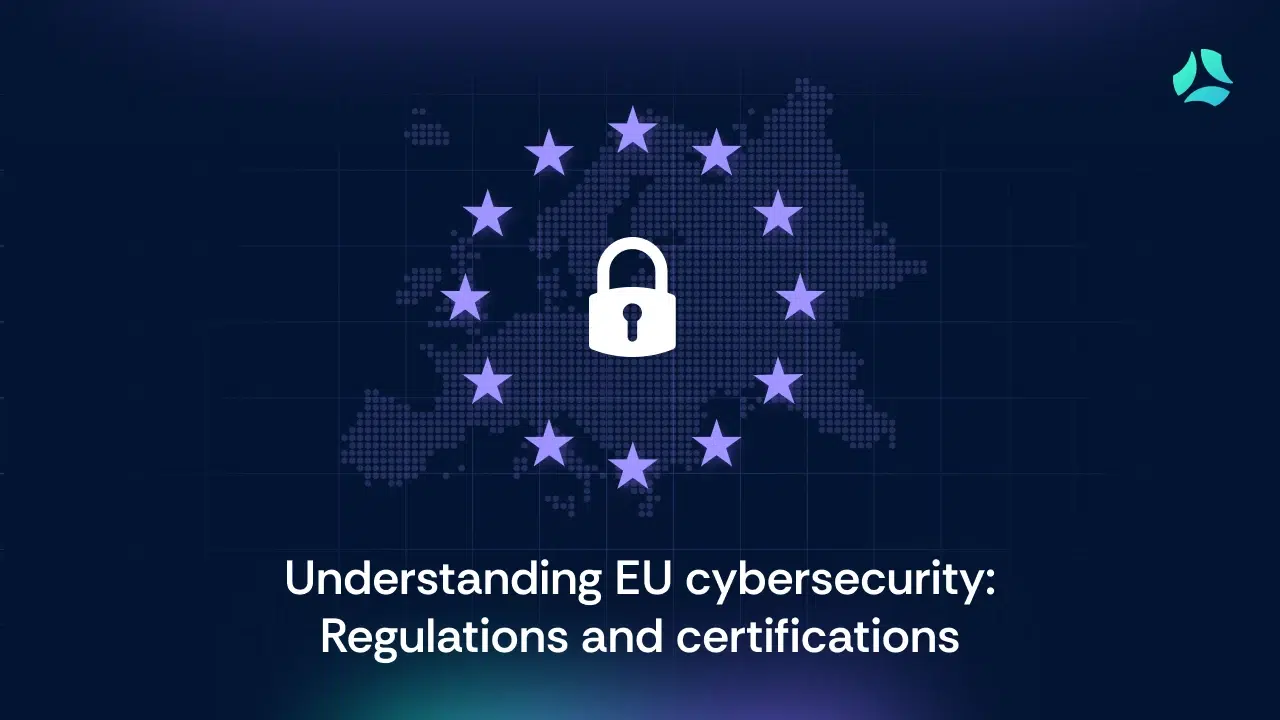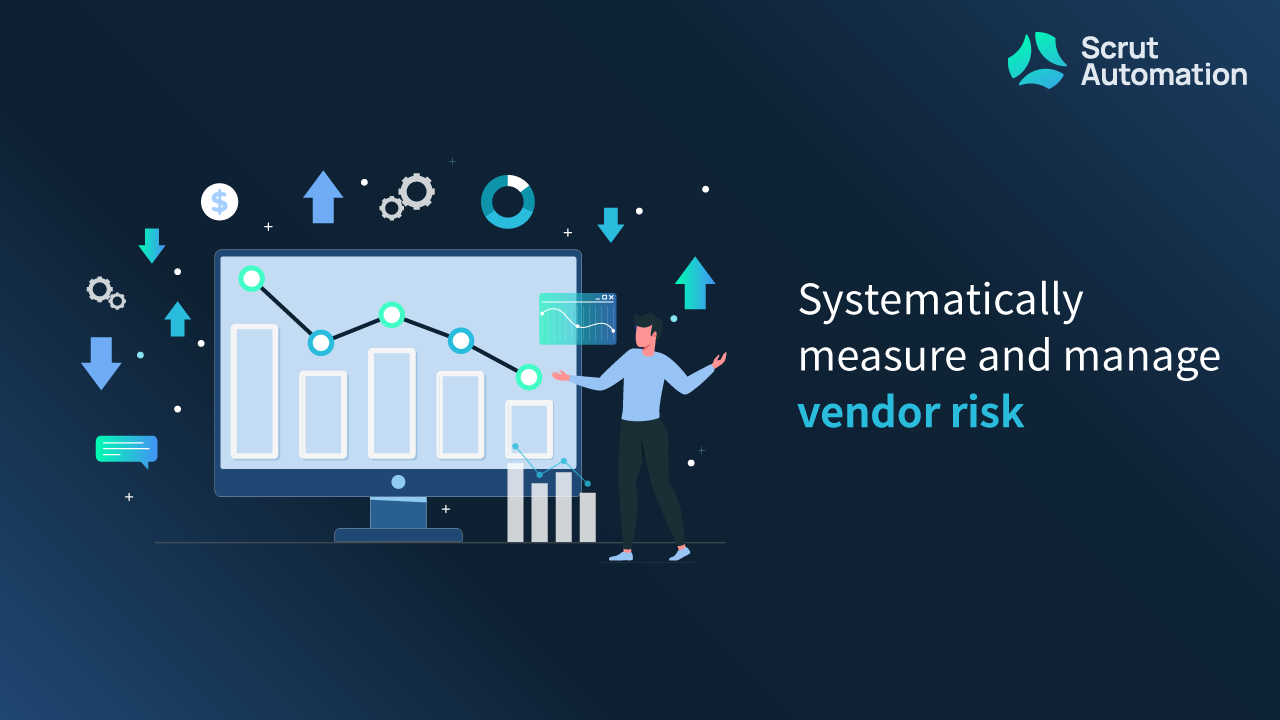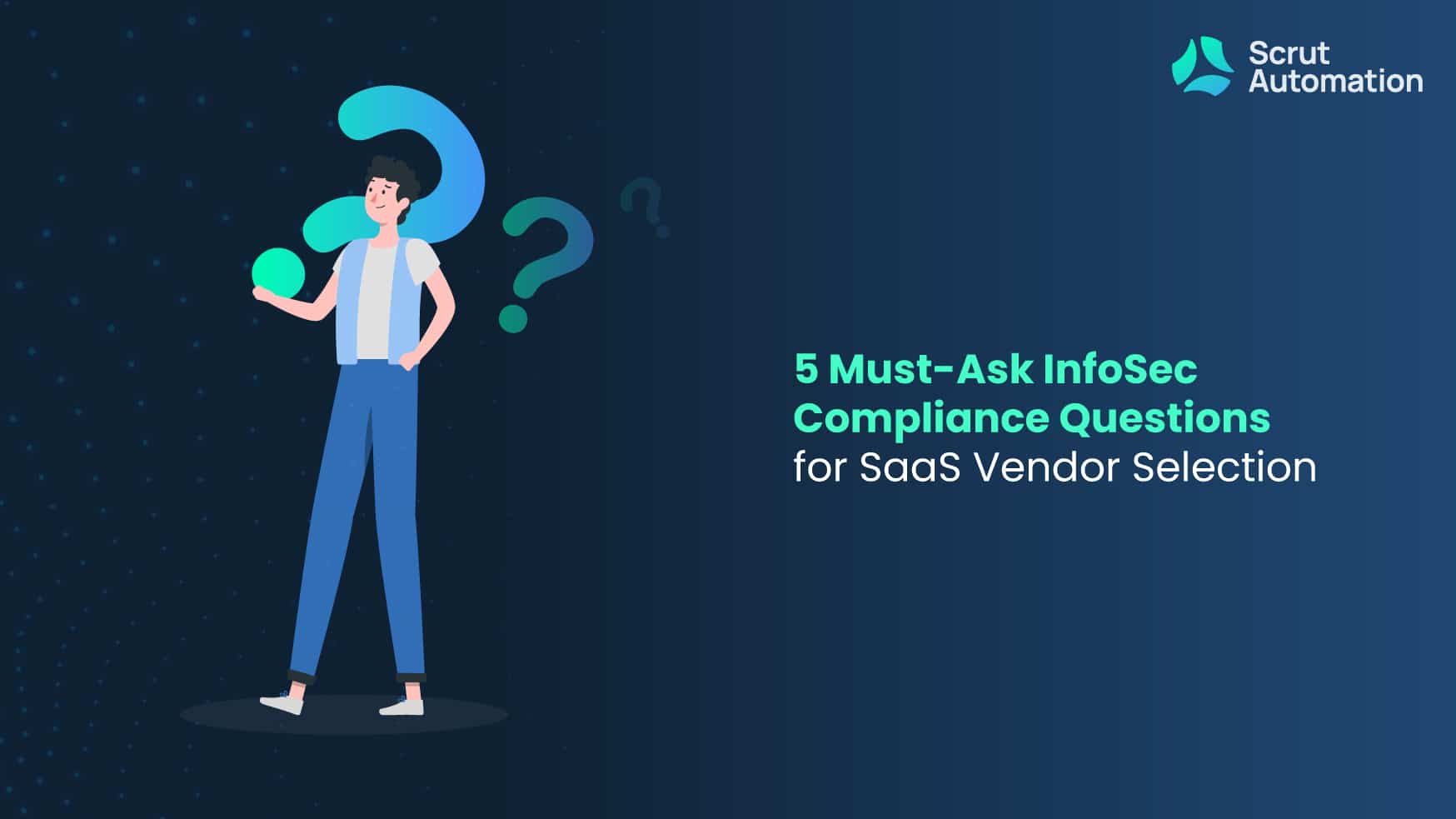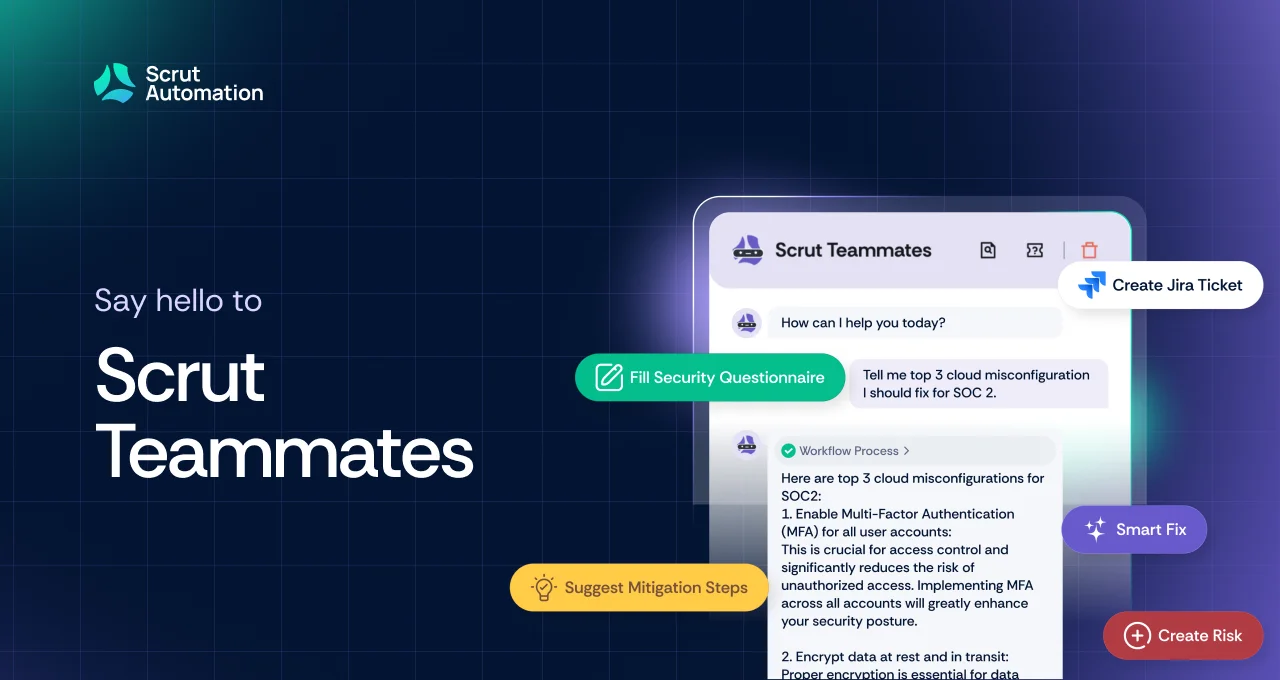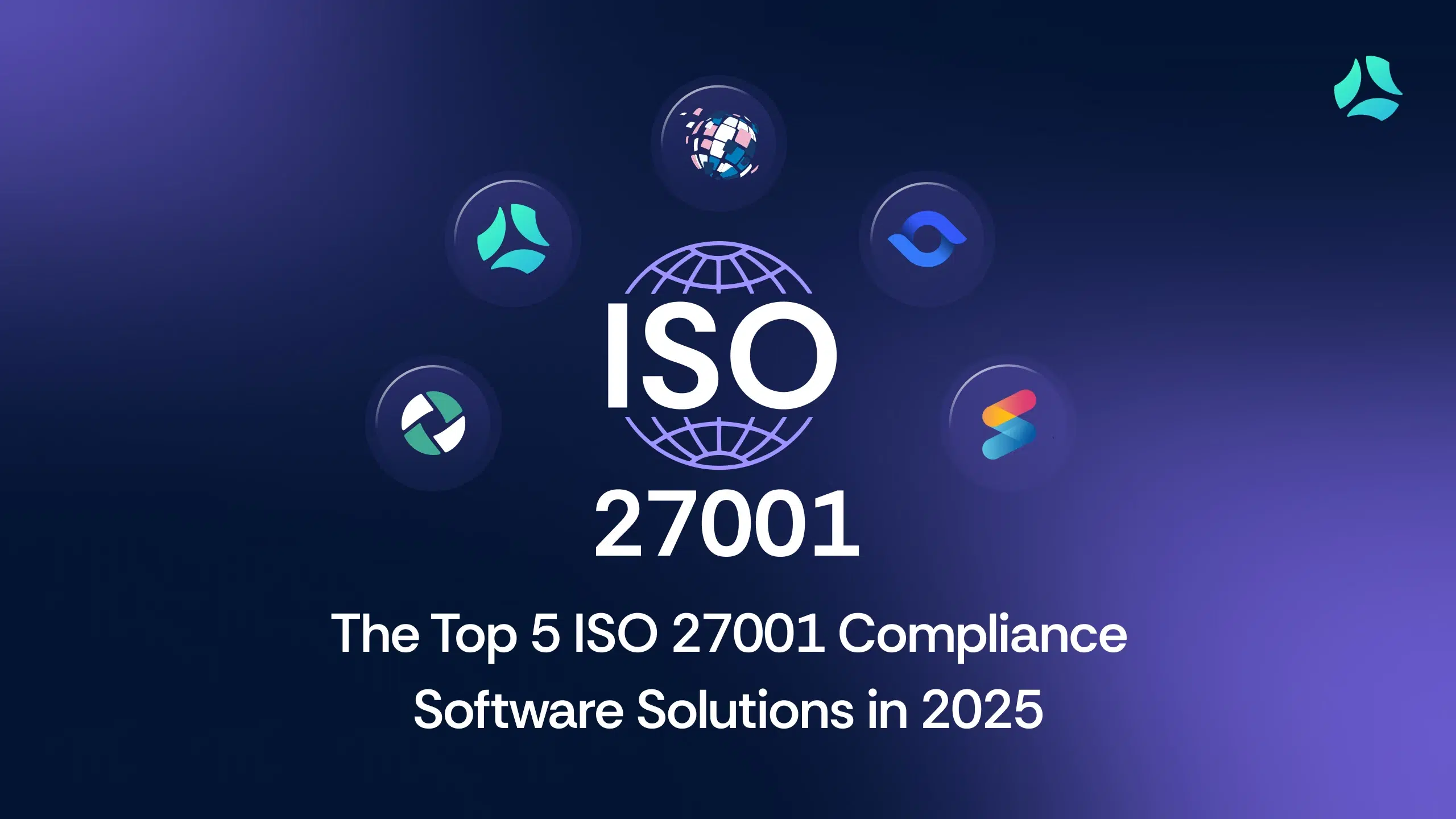In the complex landscape of healthcare data security, two key frameworks, the Health Insurance Portability and Accountability Act (HIPAA) and the International Organization for Standardization’s ISO 27001, play pivotal roles in safeguarding sensitive information.
HIPAA, a U.S. legislation, specifically addresses the protection and privacy of health information, while ISO 27001 is a globally recognized standard for information security management systems.
Healthcare organizations often face the challenge of navigating the intricate web of regulatory requirements, with the Health Insurance Portability and Accountability Act (HIPAA) addressing specific healthcare concerns and ISO 27001 providing a more comprehensive framework for information security. The problem lies in the potential misalignment of these two crucial standards. Failing to bridge the gap between the specificity of HIPAA and the broader scope of ISO 27001 can lead to inefficiencies in compliance efforts, leaving organizations vulnerable to security threats and regulatory lapses.
This blog explores the need to map your HIPAA data to ISO 27001 and delves into the intricacies of this mapping process.
Understanding HIPAA and ISO 27001: Foundations for compliance and security
The Health Insurance Portability and Accountability Act (HIPAA) stands as a cornerstone in the protection of healthcare data. HIPAA’s primary focus lies in safeguarding the privacy and security of patient information.
Key requirements include the establishment of safeguards for electronic protected health information (ePHI), stringent access controls, the implementation of audit controls, and the development of contingency plans to ensure data availability in emergencies.
Additionally, HIPAA mandates regular risk assessments, ensuring that healthcare organizations systematically identify and address potential vulnerabilities, fortifying their overall security posture.
Healthcare organizations strategically map HIPAA PHI to create a comprehensive HIPAA heat map, ensuring a nuanced understanding of data flows and vulnerabilities within their compliance landscape.
Overview of ISO 27001 standards: A global perspective on information security
ISO 27001, on the other hand, offers a comprehensive and globally recognized framework for information security management systems (ISMS). The standard is not industry-specific, making it adaptable to various sectors, including healthcare.
ISO 27001 encompasses a risk-based approach, emphasizing the identification, assessment, and management of risks to information security. It delineates a set of controls across various domains, including information security policies, human resource security, physical and environmental security, and incident management. ISO 27001’s strength lies in its adaptability, providing a versatile structure applicable to organizations of all sizes and industries.
Harmonizing HIPAA and ISO 27001: Bridging specificity with universality
Understanding HIPAA and ISO 27001 is essential for healthcare organizations seeking to navigate the intricacies of compliance and data security. While HIPAA offers targeted guidelines for safeguarding health information, ISO 27001 provides a broader, internationally recognized approach to securing information in general. The challenge lies in aligning these two frameworks effectively, leveraging the specificity of HIPAA while benefiting from the universal applicability and adaptability of ISO 27001.
Importance of mapping both frameworks for healthcare organizations
In the dynamic arena of healthcare, where data security is paramount, the intersection of the Health Insurance Portability and Accountability Act (HIPAA) and the International Organization for Standardization’s ISO 27001 holds immense significance for healthcare organizations.
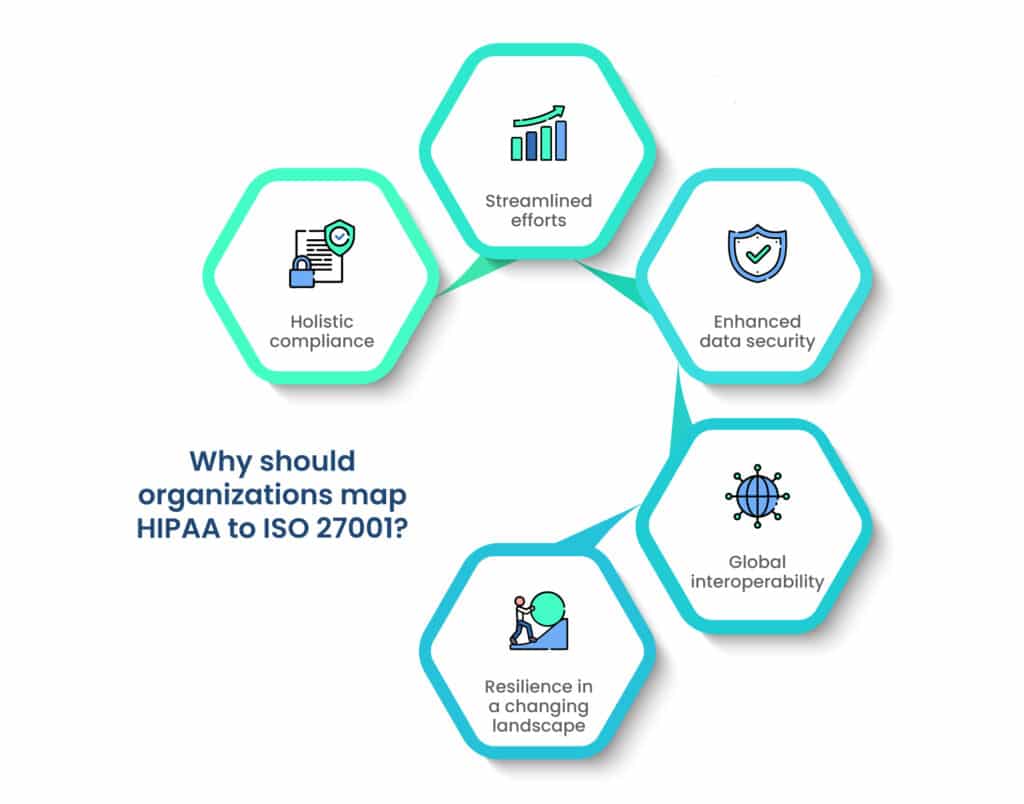
The unique challenges posed by the healthcare sector require a meticulous approach to compliance and data protection. Here’s why mapping both frameworks is crucial:
1. Holistic compliance
HIPAA outlines specific regulations tailored to the healthcare industry, while ISO 27001 provides a more comprehensive and globally recognized set of standards. Mapping both frameworks ensures that healthcare organizations not only meet industry-specific requirements but also adhere to broader international best practices in information security, fostering a holistic compliance approach.
2. Streamlined efforts
Healthcare entities often deal with a multitude of regulations. Mapping HIPAA to ISO 27001 allows organizations to streamline their compliance efforts by identifying commonalities, avoiding redundancy, and creating a unified strategy. This strategic alignment simplifies the compliance landscape, making it more manageable for healthcare professionals.
3. Enhanced data security
While HIPAA focuses on healthcare data, ISO 27001 offers a broader perspective on information security. By mapping these frameworks, organizations can enhance their overall data security measures. This not only protects patient information but also fortifies against evolving cyber threats, creating a robust security posture.
4. Global interoperability
In an interconnected world, healthcare organizations often collaborate on an international scale. ISO 27001, being an internationally recognized standard, facilitates global interoperability. Mapping to ISO 27001 ensures that healthcare entities can seamlessly integrate with partners worldwide, aligning their security practices with a universally accepted framework.
5. Resilience in a changing landscape
The healthcare industry is no stranger to regulatory changes and evolving security challenges. Mapping HIPAA to ISO 27001 provides a proactive approach, offering organizations the flexibility to adapt to changes efficiently. This resilience is critical in safeguarding sensitive healthcare data amid the ever-shifting landscape of technology and regulations.
Bridging the divide between HIPAA and ISO 27001
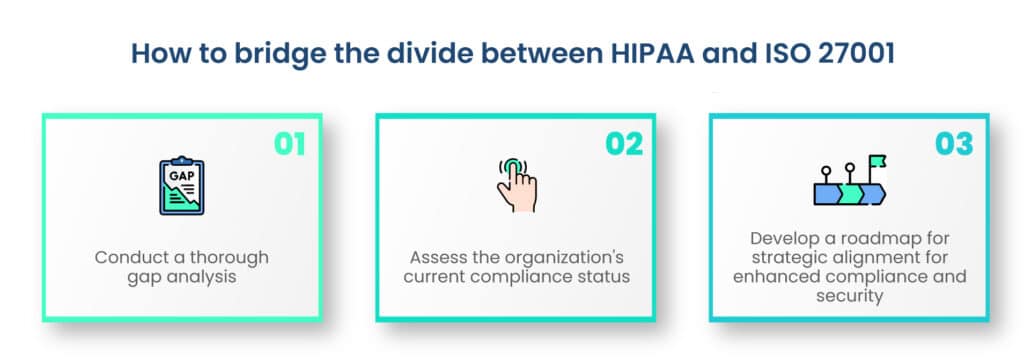
1. Conduct a thorough gap analysis
Before healthcare organizations embark on the journey of mapping HIPAA to ISO 27001, a comprehensive gap analysis is imperative. This strategic process involves a meticulous examination of the existing security measures and practices against the requirements outlined in both frameworks.
By scrutinizing the specifics of HIPAA alongside the broader provisions of ISO 27001, organizations can identify the gaps that need attention. This analysis is not merely a checklist exercise but a nuanced exploration, uncovering where the specific requirements of healthcare data protection intersect with the more comprehensive controls defined by ISO 27001.
2. Assess the organization’s current compliance status
Understanding where an organization stands in terms of compliance is fundamental. The gap analysis serves as a diagnostic tool to assess the current state of compliance with both HIPAA and ISO 27001. It involves evaluating existing policies, procedures, and technical controls against the detailed requirements of each framework. This assessment provides a clear picture of the organization’s strengths and weaknesses, highlighting areas that require immediate attention and those that align well with the standards. The insights gained from this assessment lay the groundwork for a targeted and effective mapping strategy.
3. Develop a roadmap for strategic alignment for enhanced compliance and security
By conducting a thorough gap analysis and assessing the current compliance status, healthcare organizations gain a roadmap for strategic alignment. The identified gaps serve as focal points for action, guiding the organization to bridge the divide between HIPAA and ISO 27001.
This strategic alignment not only ensures compliance with specific healthcare regulations but also positions the organization to meet the broader and evolving challenges of information security.
Building a cross-functional team: Synergizing expertise for successful alignment
Mapping HIPAA to ISO 27001 is not a task for a singular department; it requires a collaborative effort across key functions within an organization. The synergy between the information technology (IT), legal, and compliance departments is pivotal for a successful alignment.
Each department brings unique expertise to the table: IT ensures technical implementation, legal navigates the regulatory landscape, and compliance oversees adherence to standards.
The collaboration among these departments ensures a well-rounded and comprehensive understanding of both HIPAA and ISO 27001 requirements. This holistic approach mitigates the risk of oversight, fostering a more robust and effective mapping strategy.
1. Establishing roles and responsibilities within the team
Clarity in roles and responsibilities is a cornerstone of a successful mapping initiative. In building a cross-functional team, it is essential to clearly define the roles each department will play.
The IT department takes charge of technical implementations, ensuring that security controls align with both frameworks. Legal experts navigate the legal intricacies, interpreting and translating regulatory requirements into actionable steps.
The compliance department oversees the overall adherence to standards and ensures that policies and procedures align with the mapped controls. Establishing these roles and responsibilities not only streamlines the mapping process but also ensures that the organization benefits from a diverse range of perspectives, fostering a more robust and resilient security posture.
2. The power of cross-functional collaboration
A well-established cross-functional team serves as the linchpin in the successful mapping of HIPAA to ISO 27001. By leveraging the expertise of IT, legal, and compliance departments, organizations can navigate the complexities of compliance and security, ensuring that both healthcare-specific and internationally recognized standards are effectively addressed.
Mapping HIPAA requirements to ISO 27001 controls: Crafting a cohesive security framework
Mapping the intricate landscape of HIPAA requirements to ISO 27001 controls is a nuanced process that demands precision and a granular understanding of each framework.
1. Detailed mapping process for key HIPAA provisions to ISO 27001 controls
Begin by identifying corresponding controls in ISO 27001 for key HIPAA provisions.
Conduct a line-by-line analysis, ensuring that each requirement finds its counterpart in ISO 27001. This meticulous mapping process is not just about equivalence but about understanding the intent behind each provision and aligning it with the broader controls of ISO 27001.
2. Creating a structured framework for alignment
With the detailed mapping in place, the next step is to synthesize these findings into a structured framework. Develop a mapping document or matrix that clearly outlines how each HIPAA requirement corresponds to the relevant ISO 27001 control.
This document serves as a guiding roadmap for implementing security measures that simultaneously satisfy both sets of standards. A structured framework not only aids in the implementation phase but also becomes a valuable resource for audits and continuous monitoring, ensuring ongoing alignment and compliance.
3. Harmonizing specificity and universality
The essence of mapping HIPAA to ISO 27001 lies in harmonizing the specificity of healthcare regulations with the universal principles of information security. This process goes beyond a checkbox exercise; it involves understanding the nuances of each standard and creating a cohesive framework that not only meets the letter of the law but also aligns with the spirit of security best practices.
Utilizing automation tools: Streamlining the mapping process for long-term success
Navigating the intricate process of mapping HIPAA to ISO 27001 demands efficiency and accuracy. Here, the integration of automation tools emerges as a key strategy to streamline this complex task. These tools are designed to facilitate the identification and mapping of controls, ensuring a more efficient and error-resistant process. By automating repetitive tasks and providing structured frameworks, these tools empower organizations to focus on strategic decision-making rather than getting bogged down in manual, time-consuming processes.
1. Benefits of automation in maintaining alignment over time
The advantages of incorporating automation into the mapping process extend beyond the initial implementation phase. Automation tools contribute significantly to maintaining alignment over time. They provide a dynamic mechanism for tracking changes in both HIPAA and ISO 27001 requirements, automatically updating the mapping framework as needed. This proactive approach ensures that organizations stay current with evolving regulations and standards, fostering a continuous state of compliance. Additionally, automation aids in regular monitoring and reporting, offering insights into the effectiveness of implemented controls and identifying areas that may require adjustments.
2. Efficiency, accuracy, and adaptability
The utilization of automation tools not only expedites the mapping process but also enhances the accuracy of the alignment. With real-time updates and built-in validation mechanisms, these tools reduce the risk of human error and ensure that the mapping remains precise and reflective of the latest regulatory changes.
Moreover, as both HIPAA and ISO 27001 are dynamic frameworks subject to updates, automation provides an adaptable solution that can seamlessly accommodate modifications, guaranteeing a resilient and future-proof mapping strategy.
Continuous monitoring and updates: Safeguarding compliance in a dynamic landscape
Sustaining compliance is not a one-time effort but a continuous journey that requires vigilant oversight. Continuous monitoring serves as the cornerstone for maintaining the alignment of HIPAA and ISO 27001 over time.
Regularly assessing the effectiveness of implemented controls ensures that the security posture remains robust and that any deviations from compliance are promptly identified.
Continuous monitoring not only safeguards against potential threats but also provides valuable insights for refining security strategies, adapting to emerging risks, and demonstrating a steadfast commitment to data protection.
1. Regular updates to the mapping process in response to changes
In the ever-evolving landscape of healthcare regulations and information security, change is constant. To ensure the continued relevance of the mapping between HIPAA and ISO 27001, organizations must institute a system for regular updates. This involves staying attuned to changes in regulations, be it updates to HIPAA provisions or revisions to ISO 27001 standards.
Equally important is the responsiveness to shifts in the organization’s structure, ensuring that the mapping aligns seamlessly with any modifications in processes, personnel, or technological infrastructure. Regular updates not only maintain compliance but also foster an agile and adaptive approach to security.
2. Striking a balance: Proactive compliance and agility
Continuous monitoring and regular updates strike a delicate balance between proactive compliance and organizational agility. By establishing a robust monitoring system, organizations not only ensure that they meet current standards but also position themselves to swiftly adapt to future changes.
This dynamic approach not only safeguards against non-compliance risks but also instills a culture of constant improvement, aligning security measures with the evolving needs of the healthcare industry and the broader information security landscape.
Ensuring resilience: Navigating regulatory changes and security threats
In the ever-changing realm of healthcare and information security, ensuring resilience is paramount. Regulatory landscapes evolve, and new security threats continually emerge.
To navigate this dynamic environment, organizations must remain agile in adapting their security measures to align with the latest regulatory requirements. Staying informed about changes to HIPAA and ISO 27001, as well as broader industry trends, positions organizations to proactively address evolving challenges.
This adaptability not only preserves compliance but also establishes a resilient foundation capable of withstanding the uncertainties inherent in the digital landscape.
1. Strategies for maintaining a resilient security posture
Maintaining a resilient security posture involves a multifaceted approach. First and foremost, organizations should foster a culture of continuous learning and improvement, ensuring that their security measures evolve alongside regulatory changes.
Regular risk assessments play a crucial role in identifying vulnerabilities and proactively addressing emerging threats. Engaging in threat intelligence sharing and industry collaboration enables organizations to stay ahead of potential risks.
Additionally, investing in robust incident response plans and cybersecurity training ensures that the organization is well-prepared to mitigate the impact of security incidents promptly.
2. Embracing a proactive mindset: Future-proofing security measures
To truly ensure resilience, organizations should adopt a proactive mindset. This involves anticipating future changes in regulations and emerging threats and aligning security measures accordingly.
By embracing innovative technologies, such as artificial intelligence and machine learning, organizations can augment their ability to detect and respond to evolving security challenges.
Furthermore, actively participating in industry forums, attending conferences, and engaging with regulatory updates positions organizations at the forefront of industry best practices, fostering a resilient security posture that is not just reactive but anticipatory.
Audits and compliance maintenance: Upholding alignment through vigilant oversight
Regular audits stand as a cornerstone in the maintenance of alignment between HIPAA and ISO 27001. Conducting systematic assessments at defined intervals allows organizations to verify the effectiveness of implemented controls, ensuring that the mapping remains accurate and that security measures align with both frameworks.
Audits serve as a proactive mechanism for identifying any deviations from compliance standards, offering insights into potential areas of improvement, and assuring that the organization’s security posture aligns with the evolving landscape of healthcare regulations and information security.
1. Strategies for addressing any deviations or updates needed
In the aftermath of audits, addressing identified deviations or needed updates becomes a crucial phase in compliance maintenance. Organizations should establish clear protocols for remediation, outlining steps to rectify any non-compliance issues swiftly.
This process involves not only correcting immediate discrepancies but also analyzing the root causes to implement preventive measures. Moreover, organizations should ensure that these remediation strategies align with the broader security goals, facilitating a cohesive and integrated approach to compliance and data protection.
2. Fostering a culture of continuous improvement
Beyond mere correction, audits and compliance maintenance should be viewed as opportunities for continuous improvement. By embracing a culture of learning from audit findings, organizations can refine their security strategies, enhance control effectiveness, and fortify their overall compliance posture.
This iterative process ensures that the organization not only meets regulatory requirements but also strives for excellence in data protection, staying ahead of emerging threats and industry best practices.
Wrapping up: Embracing a secure future through aligned compliance
In the complex landscape of healthcare data security, the meticulous mapping of HIPAA to ISO 27001 emerges as a strategic imperative. Through the journey of understanding, mapping, and continuous maintenance, organizations not only ensure compliance with industry-specific regulations but also fortify their information security posture on a global scale.
The harmonization of these frameworks fosters resilience, adaptability, and a proactive mindset in the face of evolving regulatory landscapes and emerging security threats.
As we conclude this exploration, we invite you to take the next step in securing your organization’s compliance journey. Contact Scrut to embark on a comprehensive and tailored approach to healthcare compliance.
Frequently Asked Questions
Mapping HIPAA to ISO 27001 is crucial for organizations in the healthcare sector as it allows them to align regulatory requirements with internationally recognized information security standards. This integration enhances overall data protection, streamlines compliance efforts, and fosters a robust security framework.
HIPAA is a specific regulation focused on protecting healthcare data, while ISO 27001 is a broader international standard for information security management. Understanding these differences is vital for organizations aiming to harmonize the specific requirements of HIPAA with the comprehensive approach of ISO 27001.
Streamlining the mapping process involves conducting a thorough gap analysis, leveraging existing security measures, and creating a detailed compliance plan. Automation tools and collaboration among different departments can further enhance efficiency in aligning HIPAA with ISO 27001.
Successfully mapping HIPAA to ISO 27001 brings several benefits, including improved data security, enhanced risk management capabilities, increased interoperability with global partners, and a more holistic approach to compliance. It demonstrates a commitment to both regulatory requirements and international best practices.
Yes, common pitfalls include overlooking specific nuances in each framework, neglecting the importance of employee training, and underestimating the complexity of mapping. Organizations should carefully navigate these challenges by staying informed, seeking expert guidance, and continuously reassessing their compliance strategies.
